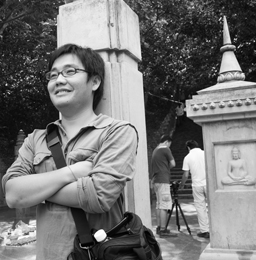Bun Tharum, Phnom Penh
On Tuesday, I attended a World Press Freedom Day forum in Phnom Penh. The theme this year was “21st Century Media: New Frontiers, New Barriers.” And while everyone was talking about Facebook and Twitter, what I found interesting was the way that information is changing in Cambodia—how it’s gathered, delivered and consumed.
In the early 2000s there were only a few online news sites, with sporadic updates, serving the Cambodian audience; none of them were actually published in Khmer language.
A decade later, Cambodia is now home to 30 Internet service providers. It’s estimated that there are around 100,000 Internet users, which has pushed major print newspapers to go online for wider distribution.
More and more computer users have adopted Khmer Unicode, with interchangeable characters on their machines, taking the exchange of information and content to the next level, something that was only possible in an alternative workaround a year earlier.
The era of dial-up connections with a speed of less than 56 kbps has been taken over by broadband and mobile Internet 3G. This new transformation in technology has changed how Cambodians consume news. Meanwhile, the media have become faster at reporting and delivering news.
World Press Freedom Day offered a chance to put all this together in many different discussions Tuesday.
Professionals debated new media, questioned how much the Internet can contribute to freer expression, and how online content can spawn new topics of discussion.
They discussed KI Media, a news aggregator openly opposed to the Cambodian government, which has been unavailable through the country’s biggest ISPs since early this year.
Information Minister Khieu Kanharith said in a talk Tuesday the government has no policy to block websites or blogs. He pointed to examples from the Middle East, Burma, Vietnam and especially China to demonstrate how hard it is to disconnect people from the Internet and the information there.
Media groups representing newspapers and radio stations say that while new media is a new threat, they’ve actually transformed it into an integral part of their newsrooms. Many Khmer-language papers now have an online edition that is updated more than once a day—a difficulty feat for daily print papers.
Pen Samitthy, president of the Cambodian Club of Journalists, told participants that the Internet has actually improved how journalists file stories. People can post from anywhere—the office, home, a café—anytime. The Internet has also made it hard for the government to censor content, he said.
In between sessions at the forum, a documentary on social media played, demonstrating how young Cambodians use Facebook to get news, updates about their friends and other information. One segment examined how Facebook helped spread news of last year’s Diamond Bridge stampede, one of the worst tragedies in Cambodia’s modern history.
This 7-minute video is courtesy of media students at Royal University of Phnom Penh, Department of Media and Communication.
Discussing the roles of social media in Cambodia, this 7-minute video was produced by journalism students at Department of Media and Communication, Royal University of Phnom Penh.
Websites for newspapers, too, are becoming increasingly popular. While a print run might circulate around 10,000 copies, some news organizations are see double that the number of unique visitors to the sites. The popularity of online news became very apparent when Cambodian and Thai troops clashed on the border; newspapers used their Web pages to update injuries and casualties and other information from the front.

A graphic from compete.com shows the number of unique visitors to three Cambodian newspaper sites. Click the image to zoom in.
In 2002, the International Telecommunications Union called Cambodia a “late comer” to the Internet, with commercial service launching late, in 1997. That may be true, but the past decade has seen a boom in infrastructure, which is helping more and more people access breaking news and information. That power comes with a warning, however. Media organizations must be careful not to sacrifice accuracy for immediacy—just for a few extra clicks.
Recommended links:
Encoded Property
“What Does Press Freedom Mean to You?”

 Radio Podcasts
Radio Podcasts YouTube
YouTube Facebook
Facebook Twitter
Twitter Google+
Google+ Angkor One
Angkor One RSS
RSS Subscribe to Email Alerts
Subscribe to Email Alerts Mobile Version
Mobile Version
2 responses to “What Information Means in Cambodia Today”
[…] students from Phnom Penh upload a video which discuss social media usage in Cambodia, including the threat to block websites which are critical to the government. […]
[…] students from Phnom Penh upload a video which discuss social media usage in Cambodia, including the threat to block websites which are critical to the […]